Occupational Environment Monitoring at Blender Manufacturing Factory
99,000 ₫
Note: The above price is calculated per sample and may vary depending on the area of the environment to be monitored and market fluctuations. For more accurate pricing support, please refer to the price list or contact our consulting staff directly.
Monitoring the environment of a blender production factory is a session for collecting, analyzing, and evaluating workplace factors that may be harmful to workers’ health.
Table of Contents
Toggle1. Overview of Blender Manufacturing Factory
a. What is a blender manufacturing factory?
Blender manufacturing factory is a facility that produces devices such as blenders, juicers, ice crushers, or other related equipment used to process and prepare smoothies, fruit juices, crushed ice, ice cream, and other food products.
Blenders are commonly used in kitchens, cafes, restaurants, and eateries to finely blend fruits, vegetables, ice, and other ingredients to create fresh and refreshing beverages.
Blender manufacturing factories typically carry out production stages such as mechanical processing, assembly, quality control, and packaging. Blenders can be produced with various power capacities and functions to meet the needs of consumers and businesses in the food and beverage industry.

b. Production stages in the blender manufacturing factory
Production stages in a blender manufacturing factory may include:
- Design and research: This stage focuses on designing and researching new models, features, and technologies for blenders.
- Component manufacturing: Blender components such as jars, blades, motors, control units, lids, and other parts are produced through mechanical processing or using molds and specialized machinery.
- Processing and assembly: Components are processed and assembled to create the complete blender. This stage includes cutting, welding, polishing, and assembling parts together.
- Quality inspection: After assembly, blenders undergo quality checks to ensure they function correctly and meet quality standards.
- Packaging: Completed and inspected blenders are carefully packaged to ensure safety during transportation and storage. Packaging may include boxes, wrappers, and other accessories.
- Transportation and distribution: After packaging, blenders are transported and distributed to stores, industrial kitchens, or end customers.

c. Machinery used in the blender manufacturing factory
In a blender manufacturing factory, the following types of machinery and equipment may be used:
- Cutting and mechanical processing machines: Used to cut, bend, and process metal parts such as jars, blades, and frames.
- Welding machines: Used to weld metal components together or perform other welding processes such as submerged arc, spot, and TIG welding.
- Polishing machines: Used to polish metal surfaces to make them smooth and shiny.
- Plastic molding machines: Used to mold plastic components of blenders, including lids and housing.
- Lathes and milling machines: Used to machine metal parts into required shapes and sizes.
- Plastic processing machines: Used to process and shape plastic parts, including cutting, bending, and forming.
- Printing and laser engraving machines: Used to print or engrave brand logos, symbols, or images on blender components.
- Quality testing machines: Used to check the performance, operation, and specifications of assembled blenders.
- Packaging machines: Used for packaging blenders, including boxing, shrink-wrapping, and sealing machines.

d. Occupational diseases for workers in the blender manufacturing factory
Workers in a blender manufacturing factory may develop certain occupational diseases in the workplace, such as:
- Respiratory diseases: Workers exposed to dust, fumes, or smoke may experience asthma, bronchitis, pneumonia, or long-term impacts on respiratory system development and function.
- Hearing issues: Continuous noise from machinery and equipment can cause hearing loss or deafness.
- Skin diseases: Prolonged contact with cleaning agents, detergents, and chemicals may cause skin irritation, dermatitis, eczema, or allergies.
- Spinal and musculoskeletal problems: Working in improper postures or frequently lifting heavy machinery parts may cause back pain, cervical spine degeneration, and other musculoskeletal issues.
- Hand, eye, and other musculoskeletal problems: Repetitive activities such as pressing buttons, screwing, or using tools may result in injuries or disorders such as muscle inflammation, tendon sheath inflammation, nerve inflammation, or problems affecting hands and neck.
To ensure occupational safety and prevent occupational diseases, it is necessary to implement personal protective measures, comply with safety regulations, use proper protective equipment, ensure proper ventilation, and effectively manage harmful substances in the work environment.

e. Popular types of blenders on the market
Currently, there are various popular types of blenders with different features and capacities. Some common types include:
- Standard blenders: Basic models used to blend fruits, vegetables, and other ingredients. Speed and blending time can be adjusted as needed.
- Multifunction blenders: Not only blend smoothies but also make juice, crush ice, grind beans, make ice cream, and other tasks. More versatile and flexible than standard blenders.
- Professional blenders: Designed for restaurants, hotels, or industrial kitchens. High power, durable, and faster blending. Made with high-quality materials for durability and performance.
- Personal blenders: Compact, easy to use and clean. Suitable for home, office, or travel use.
- Multi-tier blenders: Designed with multiple layers of blades working simultaneously for faster and smoother blending.
- Industrial blenders: For large-scale production, such as food factories or beverage processing plants. High capacity and processing ability to meet mass production needs.
2. Overview of occupational environment monitoring service
a. What is occupational environment monitoring at a blender manufacturing factory?
Occupational environment monitoring (or workplace environment measurement) at a blender manufacturing factory is the activity of collecting, evaluating, and analyzing measurement indicators of workplace environmental factors. The aim is to implement timely corrective measures, minimize environmental harm to workers’ health, and prevent occupational diseases. Occupational environment monitoring is a mandatory requirement for blender manufacturing factories.
Monitoring plays a vital role in protecting, caring for, and improving worker health because the primary resource of a business and the direct source of profit is its workforce. Workers regularly exposed to risk factors above allowed limits may experience health issues and develop occupational diseases.
REGISTER FOR OCCUPATIONAL ENVIRONMENT MONITORING SERVICE
b. Nam Viet’s occupational environment monitoring program
Nam Viet’s occupational environment monitoring program is developed by monitoring engineers specializing in occupational safety and environmental protection. To ensure worker health and safety, the program uses modern measurement methods to monitor air, water, microclimate, physical factors, dust, and other workplace elements. This program is crucial for ensuring a safe working environment and protecting worker health.
Furthermore, Nam Viet’s program also plays an important role in researching and developing new solutions to improve workplace quality. With a dedicated and professional team of monitoring experts, Nam Viet’s exclusive monitoring program is a breakthrough in labor safety management and environmental protection in Vietnam.

c. Standardization in workplace environment measurement procedures
Standardization in Nam Viet’s workplace environment measurement procedures is critical to ensure measurement quality. To guarantee accuracy and reliability, the program follows standards and standardized procedures recognized by Ho Chi Minh City Department of Health. This ensures that collected data is highly reliable for evaluating workplace environments and making decisions to improve worker safety and health.
These standardized procedures also ensure that measurements are performed by highly qualified monitoring specialists with years of experience, allowing managers and experts to trust Nam Viet’s results for accurate and valuable decision-making to protect worker health and the environment.
By applying standardized procedures, Nam Viet demonstrates its commitment to ensuring a safe working environment and protecting worker health, while actively contributing to the development and improvement of occupational safety and environmental management in Vietnam.
d. Reporting results of occupational environment monitoring at the blender manufacturing factory
Monitoring results are prepared according to Form No. 04, Appendix III of Decree 44/2016/ND-CP and produced in two copies: one sent to the contracting workplace and one retained by the monitoring organization.
The retention period for monitoring results follows legal regulations and is indefinite.

e. Frequency of occupational environment monitoring according to law
According to Clause 2, Article 18 of Labor Safety and Hygiene Law 84/2015/QH13, employers must conduct occupational environment monitoring to assess harmful factors at least once a year.
f. Deadline for submitting occupational environment monitoring reports
The deadline for submitting reports is before December 31 each year. Enterprises operating production facilities must submit monitoring results to the local Department of Health where their headquarters and employees are located.
When there are changes in technology, production processes, or facility upgrades that may introduce new harmful factors, enterprises must update occupational hygiene records regarding elements requiring environmental monitoring.
g. Penalties for violations of occupational environment monitoring by employers
According to Article 27 of Decree No. 12/2022/ND-CP dated January 17, 2022, on administrative penalties in labor, social insurance, and Vietnamese workers working abroad under contract:
- Clause 2: Fine of 2,000,000 – 5,000,000 VND for employers who fail to publicly inform workers at the monitored workplace about monitoring results and hazard management immediately after obtaining the results.
- Clause 3: Fine of 20,000,000 – 40,000,000 VND for employers who fail to conduct occupational environment monitoring to control health hazards as required by law.
- Clause 4: Fine of 40,000,000 – 60,000,000 VND for employers who collude with monitoring organizations to commit fraud in environmental monitoring activities but have not reached the level of criminal liability.
3. Harmful Environmental Factors for Workers in Blender Manufacturing Factories
Workers in blender manufacturing factories may encounter the following harmful environmental factors:
- Noise: Blenders generate loud sounds, especially high-power blenders. Continuous and excessive noise can cause fatigue, stress, and hearing damage.
- Dust and chemical fumes: Grinding ingredients such as fruits, vegetables, and seeds can produce dust and fumes. Prolonged exposure can irritate the eyes, respiratory system, and skin.
- Voltage and temperature: Blender factories often have many electrical devices and high voltage. In addition, blenders generate heat during operation, creating high temperatures around the machines. Unsafe voltage and temperature can be hazardous to workers.
- Cleaning agents and chemicals: During cleaning and maintenance, detergents and chemicals may be used. Exposure without proper protection can irritate skin, eyes, and respiratory tracts.
- Machinery safety issues: Blender factories use many machines and tools. Risks of accidents, such as cuts, crushing, electric shocks, and rotating parts hazards, may occur if safety rules are not followed or protective equipment is not used.
REGISTER FOR OCCUPATIONAL ENVIRONMENT MONITORING SERVICE
4. Measures to Improve the Working Environment in Blender Manufacturing Factories
To improve the working environment in blender factories and protect worker health, the following measures can be applied:
- Ensure good ventilation: Install effective ventilation systems to reduce noise, heat, and dust. This can include windows, exhaust fans, air conditioning, or industrial ventilation systems.
- Use protective equipment: Ensure workers are equipped with personal protective equipment such as safety goggles, masks, helmets, gloves, and dust-resistant clothing. This protects them from dust, chemical fumes, and potential machinery injuries.
- Safety instructions and training: Train workers on safe working procedures and correct use of protective equipment. Provide clear guidance on safely operating machinery and preventing workplace accidents.
- Regular inspection and maintenance: Perform periodic inspections and maintenance of machinery to ensure safe and efficient operation. This includes checking cutting parts, electrical systems, cooling systems, and overall hygiene of the blenders.
- Waste management: Ensure safe and regulated handling of production waste. This may include waste treatment systems, sorting and recycling waste, and following proper disposal rules.
- Periodic environmental assessment: Conduct regular environmental evaluations to comply with air quality, noise, and waste regulations. Monitoring helps detect issues early and implement corrective measures.
- Compliance with safety and environmental regulations: Follow all occupational safety and environmental regulations, including the safe use of chemicals, waste management, and adherence to voltage and temperature safety standards.
- Periodically conduct occupational environment monitoring in factories, collect and analyze harmful factors for workers, and implement measures to reduce hazards and prevent occupational diseases.
5. Benefits of Regular Blender Factory Environmental Monitoring
An Toan Nam Viet provides enterprises with excellent benefits when using occupational environment monitoring services in accordance with Decree 44/2016/ND – CP on managing and controlling harmful factors in the working environment affecting workers.
- Enterprises can proactively control harmful factors in workshops or factories.
- Receive recommendations to mitigate hazards and improve working environment quality.
- Indirectly protect human resources, a key factor in business development.
- Minimize the impact of occupational diseases on health, reducing future treatment costs.
- Improved worker health leads to better product quality and consistent output.
- Ensure compliance with occupational safety laws and avoid legal risks.
- Enhance enterprise credibility and professionalism, elevating the brand.
Nam Viet’s environmental monitoring service is a solution to reduce occupational disease hazards, contributing to a clean and high-quality working environment.

6. Nationwide Occupational Environment Monitoring Center
Nam Viet Occupational Environment Monitoring Center is a professional unit specializing in monitoring and measuring occupational environment quality across all provinces in Viet Nam. With a team of experienced monitoring specialists, the center uses modern measuring equipment to ensure accuracy and reliability.
In addition to monitoring services, the center assists clients in planning, handling, and tracking occupational environment issues. With the motto “customer-centric,” the center prioritizes client satisfaction, meets all client needs, and commits to providing the best solutions for enterprises.
REGISTER FOR OCCUPATIONAL ENVIRONMENT MONITORING SERVICE
With investment in technology, equipment, and personnel, Nam Viet’s monitoring center has become one of the most reputable units in occupational environment monitoring in Ho Chi Minh City, with the following objectives:
- We always value our brand reputation and the quality of our services.
- We provide clients with the best and most suitable solutions.
- With a team of experienced Masters and Engineers, committed to protecting the environment and benefiting enterprises.
- Clients using Nam Viet Environmental Monitoring will receive professional service from experts in the field, along with the best cost advantages.
The occupational environment monitoring process at Nam Viet includes the following basic steps:
- Before conducting monitoring, we ensure all equipment is calibrated and meets legal requirements.
- Follow the occupational environment monitoring procedures as committed to the Department of Health.
- Accurately report monitoring results to employers.
- If monitoring results indicate unsafe conditions for workers, Nam Viet will assist in implementing corrective measures, and the enterprise will:
- Implement measures to improve working conditions and minimize harmful factor impacts, preventing occupational diseases.
- Organize health check-ups to detect occupational and related diseases early for workers in unsafe environments.
- Provide compensation in kind for workers according to labor law regulations.

7. Occupational Environment Monitoring Price List
To help enterprises conduct professional and effective occupational environment monitoring, Nam Viet provides clients with a detailed price list for monitoring services that is high-quality and reasonably priced.
- Our price list provides detailed information about monitoring service costs, including transportation, measurement, analysis, and report preparation. Clients can trust the accuracy and reliability of our monitoring reports.
- We commit to offering competitive and reasonable prices while providing prompt and professional consultation for any monitoring service inquiries.
- With Nam Viet’s price list, clients can easily select service packages that suit their needs, ensuring maximum satisfaction with professional service quality.
No comments yet

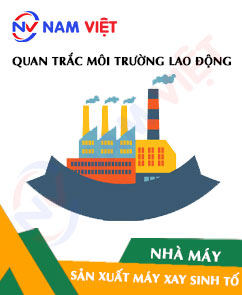
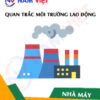
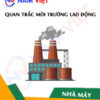
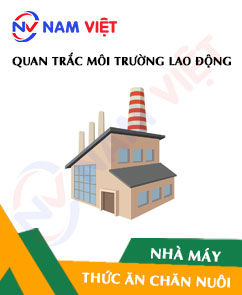




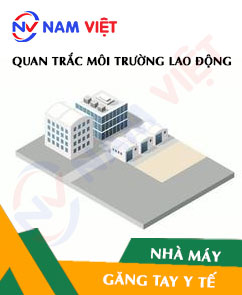
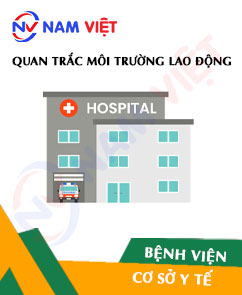
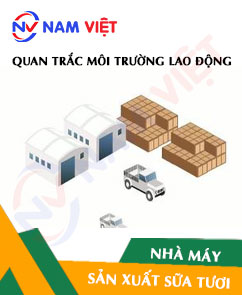
Review Occupational Environment Monitoring at Blender Manufacturing Factory
There are no reviews yet.